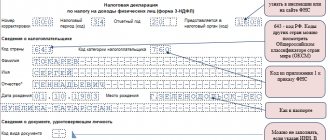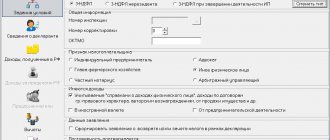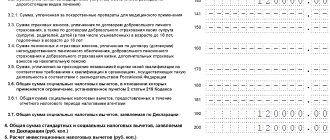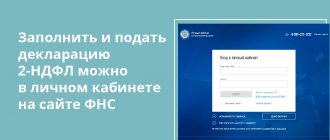Ask a lawyer online
faster. It's free!
When purchasing an apartment, citizens have the right to take advantage of a property tax deduction. To do this, you must submit an application and declaration to the Federal Tax Service in form 3-NDFL for 2022.
Who can claim a property deduction for purchasing an apartment?
Citizens of the Russian Federation will be able to receive a tax deduction:
- receiving income subject to personal income tax at a rate of 13%;
- those who did not receive the full amount of 260 thousand rubles;
- who bought an apartment, room or share in it and registered ownership of it in Rosreestr.
There are several features of providing a property deduction:
- citizens can purchase a residential property and register ownership of it for a minor child, returning the amount of the property deduction to themselves within the limit established by law (260 thousand rubles). The child is not subsequently disqualified from taking advantage of such tax relief in respect of his or her home purchase;
- For an apartment acquired by spouses in joint ownership, both spouses have the right to return the tax within the limits of expenses incurred. In this case, it does not matter to whom the object is registered. Each spouse can apply to the tax authority and receive a deduction for expenses of no more than 2 million rubles
For example: an apartment was purchased as joint property by the Ivanov spouses at a cost of 7 million rubles. Each of them can submit a package of documents to the tax authority and return personal income tax in the amount of 260 thousand rubles. If the cost of the apartment is less than 4 million rubles, the spouses have the right to distribute the deduction among themselves at their own discretion.
Citizens who bought an apartment from persons recognized by the Tax Code as interdependent (clause 1, clause 10, 11 clause 2 of Article 105.1 of the Tax Code of the Russian Federation) will not be able to take advantage of the property deduction. Namely, close relatives:
- parents;
- spouse;
- children;
- brothers and sisters;
- guardians or ward;
- subordinates by official position.
What does “tax refund” mean when buying a home?
Most people work and receive remuneration (for example, a salary) to provide for themselves and those who depend on them. Such remuneration is also called a person’s “income” and, according to the legislation of the Russian Federation, tax must be paid on it (personal income tax).
In most cases, the person who pays the income is obligated to withhold and transfer personal income tax to the state: the employer, the customer under a civil process agreement, etc. That is, a person most often receives amounts from which personal income tax has already been withheld, and the tax withholding process can be influenced only indirectly. For example, if you have the right to a standard deduction, contact your employer with a request to provide it. Or, knowing about the tax deduction due to him, you can return the “extra” personal income tax paid to the state.
The mechanism looks like this:
In order to correctly fill out the personal income tax return declaration, you need to actually reflect this scheme on the declaration sheets. Let's look at how to do this.
What is 3-NDFL in 2021
Declaration 3-NDFL for 2022 is prepared according to a new form. The form was approved by order of the Federal Tax Service dated August 28, 2020 No. ED-7-11/615.
The new form 3-NDFL is valid for periods starting with reporting for 2020 .
Forms exist in both paper (machine-readable) format and electronic format.
Individuals can still submit the 3-NDFL declaration both on paper and through TKS channels.
You can read about the metamorphoses that have occurred with the 3-NDFL declaration form recently in our article “3-NDFL Declaration in 2022 and 2022.”
NOTE!
In 2022, the possibilities for filing an electronic 3-NDFL declaration have expanded significantly. This can be done through the taxpayer’s personal account (PA) on the Federal Tax Service website, the functionality of which has been supplemented so that declarations for 2018-2020 can be filled out and submitted in one online visit. In addition, current versions of the “Taxpayer” and “Declaration” programs are available for free download, files from which can be downloaded and sent to the Federal Tax Service also through your personal account.
Through LC it is especially convenient to prepare a declaration only for deductions . With the improvement of the Tax Service programs, with a personalized login to the personal account in the form of a 3-NDFL declaration for 2022, income and personal income tax declared for the period by tax agents (employers, customers under GPC agreements, etc.) automatically appear. All that remains is to check them with income certificates and enter information about the right to deduction.
Next, we will analyze situations with the preparation of a paper version of the 3-NDFL declaration for 2022 in the free Federal Tax Service program. However, using the examples given, you can check the correctness of the report obtained in the LC.
Composition of the 3-NDFL declaration
Declaration 3-NDFL is a multifunctional document. It is used not only to process refunds, but also to pay (additional) tax for the past year on various grounds. They just use their own sheets for different purposes.
Starting from 01/01/2019, a new form of declaration 3-NDFL is in effect, approved by the Order of the Federal Tax Service dated 10/03/2018 No. ММВ-7-11/ [email protected] You must “surrender” for 2022 using this form.
form in a convenient Excel format for filling out manually.
The title page of the declaration must be completed. It contains input data that allows tax authorities to identify who submits the report, on what grounds and for what period. In this material we will not dwell on the title page in detail. Our article “Deduction codes in the new 3-NDFL” can help you fill it out.
To correctly fill out Section 1 and Section 2 of the declaration, you must first understand the appendices to 3-NDFL - we will place them in accordance with the diagram:
| What we reflect | Possible options | What is the application in the 3-NDFL declaration |
| Income taxed at a rate of 13%, from which a deduction can be made (orange color in the diagram) | Income received in the Russian Federation. This refers to income received by a resident of the Russian Federation from a resident of the Russian Federation (and not just physically on the territory of Russia). | Annex 1 |
| Income from sources outside the Russian Federation: received by a Russian resident and paid by a non-resident. Such income is also taxed in Russia at a rate of 13%, so can be taken into account when determining the deduction | Appendix 2 | |
| Income from business activities and private practice. They are taxed at 13% and can be deducted. Individual entrepreneurs cannot take into account their income under special regimes when deducting personal income tax. Only the one that is taxed under OSNO and declared in 3-NDFL | Appendix 3 | |
| Deductions (green color on the diagram) | Deduction (with calculation) for the purchase of residential real estate | Appendix 7 |
| Mortgage interest deduction | Appendix 7 | |
| Standard, social, investment deductions | Appendix 5 |
Thus, most working citizens will need Appendices 1 and 7 to fill out a declaration for property deduction. Appendix 5 may be needed to correctly reflect data from the certificate provided by the employer in 3-NDFL.
Of course, there are more deductions than are included in this table. More information about other “popular” types of deductions can be found in the article “Deduction for treatment” and “Deduction for education.”
How to fill out a declaration?
The declaration form is established by order of the Russian Tax Service dated December 24, 2014 No. ММВ-7-11/671 , which also describes the rules for filling out each page of the declaration.
Changes are made to Form 3-NDFL every year. Before filling out the declaration, you need to make sure that the version of the form corresponds to the current year and takes into account the latest edition. Using an outdated form may result in the tax office refusing to accept documents and requiring you to file a corrective return.
Basic filling rules:
- The declaration must be filled out legibly, in capital block letters and numbers.
- Each character is written in a separate cell.
- All empty cells must be filled with dashes.
The declaration form consists of a title page, sections 1, 2 and sheets A, B, C, D, D1, D2, E1, E2, G, H, I. To apply for a deduction for mortgage lending, you must fill out:
- title page;
- section 1 and 2;
- sheet A, B, C or D;
- sheet D1.
Sections 1 and 2 are completed after completing sheets A-D.
- The Title Page contains information about the taxpayer:
- The year for which the deduction is received (for example, “2017” if the return is filed in 2022 for 2022).
- Correction number (0 when submitting the first declaration, then 1, 2, etc.).
- Code of the tax office to which documents will be submitted (at the place of residence).
- Country code (643 for Russia).
- Taxpayer category code – 760 for individuals, 720 for individual entrepreneurs.
- FULL NAME. (patronymic name is not indicated if there is none).
- Date and place of birth indicated in the passport.
- Information about the passport (series, number, by whom and when issued).
- Address. Indicate the registration address as in your passport.
- Phone number with city and country code (no spaces or dashes).
- Number of pages of the declaration. This field should be filled in last, as you may end up with a different number of sheets.
- The number of pages of attached documents (or copies thereof) listed at the beginning of the article.
- Sheets A are filled out by persons employed in the Russian Federation. To fill out, you will need information from the 2-NDFL certificate. The name of the employing organization is indicated in full without quotation marks. This sheet also contains information about lottery winnings, if any.
- Sheet B is filled out by those who received income from foreign companies.
- Sheet B is filled out by individual entrepreneurs, lawyers and individuals in private practice.
- Sheet D is filled out if payments were received during the year at the birth of a child or adoption.
Only sheets that reflect income for the previous year are filled out. If there was no income of a certain type, then the corresponding sheets are not filled out. - Section 2 contains summary information about income received and taxes paid. It is filled out by summarizing the information in sheets A-D.
- Section 1 contains information about the amount that is due back this year. To be completed based on Section 2.
- Sheet D1 contains information about the property.
Let's look at filling out sheet D1 in detail:
1.1 Depending on the type of real estate, indicate:
- House;
- apartment;
- room;
- share in the property;
- land plot for individual residential construction;
- a plot of land with a house located on it;
- house with land.
1.2 Type of ownership:
- individual;
- general share;
- joint;
- child's property.
1.3 Depending on who the owner of the object is, the following is indicated:
- 01 – if the taxpayer is the only owner;
- 02 – if the declaration is submitted by the owner’s spouse in case of joint ownership;
- 03 – the declaration is submitted by the parent whose minor child is the owner;
- 13 – in case of shared ownership with a child;
- 23 – with shared ownership of a spouse and child.
1.4 Indicate 1 – for pensioners, 0 – for persons of non-retirement age.
1.5 Information about the object:
- object number (indicated in the certificate of registration of ownership);
- object address (with index).
1.6 Date of the acceptance certificate (if such a document is available).
1.7 Date of registration of ownership of a residential house/apartment/share.
1.8 Date of registration of ownership of the land plot (if any).
1.9 Date of application for distribution of property deduction (indicated if the object was acquired into common joint ownership without division into shares).
1.10 Share in the acquired property (indicated if the declaration is submitted for the first time and the right to deduction accrued before 01/01/2014).
1.11 The year in which the taxpayer began to receive a deduction for the item.
1.12 The amount of expenses for the acquisition of the object (excluding interest).
The maximum amount with which you can receive a refund is limited to 2 million rubles. If the cost of the purchased property is less, the remaining amount is transferred to the next property. If the cost is more, exactly 2,000,000 is indicated.
1.13 – Amount of interest actually paid (indicated from the certificate of interest paid to the bank).
The maximum amount of interest paid, from which a refund can be obtained, is limited to 3 million rubles.
Paragraphs 2.1-2.4 when filing a declaration for the first time will be equal to 0. When filing declarations in subsequent years, these paragraphs must indicate the amount of deductions received for the previous years for this object.
2.5 – The tax base for income is indicated at a rate of 13% (from certificate 2-NDFL).
2.6 – The amount of expenses for the purchase of real estate is indicated, equal to the amount of the tax base for the year from section 2.
2.7 – The amount of interest paid for the year is indicated (based on the “amount in clause 2.5 minus the amount in clause 2.6”).
The amount that can be refunded in a year is limited to the amount of taxes paid that year. If the taxes paid for the year are not enough to refund the entire amount, then the remaining amount can be received next year.
2.8 – Indicate the remaining amount of the deduction for the purchase of housing without taking into account interest (calculation using the formula “the amount in clause 1.12 minus the amount in clause 2.1”).
2.9 – The remaining amount of interest allowed for return is indicated (calculated using the formula “the amount in clause 1.13 minus the amount in clause 2.7).
After entering all the necessary data, you need to indicate on the title page the resulting number of pages of the declaration.
Tax deduction FOR INTEREST ON MORTGAGE
We declare income and withheld tax in 3-NDFL
In Appendix 1 you need to show the inspection inspectors that:
- during the year income was received from which deductions can be made;
- Personal income tax is withheld from them and transferred to the budget.
Supporting documents are required for this section!
The most common of them is a certificate, which until 2019 was called 2-NDFL, and is now called a certificate of income and tax amounts. You need to obtain such a certificate from your employer or other similar person (for example, a customer under a civil process agreement). If there is more than one, you need to take certificates from each income payer.
Filling out Appendix 1 on the income certificate is quite simple:
Appendix 1 contains several blocks for entering data. For one source of income at a rate of 13% (and a certificate from it) - one block. At the top of the block we indicate the data of the person who paid us from Section 1 of the certificate. At the bottom of the block we indicate the total amount of income from the same certificate and the amount of tax withheld. We take the data from Section 5.
If there are several payment sources, fill out a separate block for each. Then we transfer what happened in terms of income and deductions already made to Section 2:
If there were several sources of income in the year (for example, you worked for several employers), then we summarize the data for Section 2 of the declaration: income with income, withheld tax with withheld tax.
Determining deductions for 3-NDFL
In order to correctly fill out the declaration, we will determine exactly what amount of deduction can and should be declared for the past year.
The deduction can be:
- The main property, relying on the very fact of purchasing housing. It amounts to a maximum of 2,000,000 rubles and can be used in parts. The main rules regarding the possible amount of deduction for the year: it cannot be more than the cost of the purchased residential property and cannot be more than the income indicated in the declaration.
For example, if you bought an apartment for 1,700,000 rubles, and your income for the year was 900,000 rubles, then the maximum deduction that you can claim for this year is 900,000 rubles. And in total for this apartment you can claim a maximum of no more than 1,700,000 rubles (its cost) over the course of several years.
The amount of the main deduction may also be adjusted if the property was purchased in shares. If this is your case, we recommend that before filling out the declaration, you familiarize yourself with the possible nuances of distributing the deduction to several recipients who own shares.
See the article “Nuances of property deduction in 2022.”
- On paid mortgage interest. If you include mortgage interest in your return, check that the deduction for it is correctly defined.
Both deductions for tax refund require documentary evidence! Minimum:
- purchase and sale agreement (or DDU),
- act of acceptance and transfer of an apartment from the seller to the buyer,
- documents confirming the fact of payment for the purchase from one’s own funds (but not at the expense of maternal capital, not at the expense of various government programs and subsidies, etc.).
To deduct interest, you will definitely need a certificate from the creditor bank about the amount of interest paid. To make a deduction for the purchase of a home, you should have a certificate from the Unified State Register of Real Estate, confirming the emergence of ownership rights to the apartment (share, house).
How to submit?
The declaration for property deduction for the year is submitted after the end of the calendar year. It takes up to three months to verify all submitted documents; an additional one month is required to transfer funds. Thus, the total period for receiving a refund is four months.
- On the website of the Federal Tax Service there is an online form for filling out 3-NDFL. From the taxpayer’s personal account, you can immediately send a completed declaration to the tax authority, generate a refund application and upload scanned documents. The advantage of this option is that you do not need to personally go to the tax office.
- It is permissible to fill out the declaration by hand and personally take it to the tax office at your place of residence. In this case, the declaration is printed page by page (double-sided printing is prohibited) and filled out in block letters with a blue or black pen. If you submit documents in person, it will take more time, but the tax inspector will additionally check the correctness and completeness of the documents, which will help to quickly make adjustments in case of errors.
Corrections are not allowed in the declaration. If errors are found, you must fill it out again. In this case, the verification period will begin again, so it is important to carefully check the documents.
Above you can see an example of filling out 3-NDFL when purchasing an apartment with a mortgage.
We declare deductions in 3-NDFL
Let's imagine that a citizen, whose certificate of income and tax amounts we use in the example of filling out income, has the following rights to deduction:
- 400,000 rubles - the balance of the main deduction carried over from previous years;
- 70,000 rubles - interest paid to the mortgage lender in 2022;
- 59,000 rubles - interest paid on the mortgage in 2018.
The total amount that can be deducted (529,000 rubles) is less than the amount of income that has already been reflected in the declaration. This means that the required conditions for deduction are met and everything can be included in Appendix 7.
13 percent return on mortgage when buying an apartment
Purchasing an apartment involves the transfer of funds from the buyer to the seller. The buyer incurs costs, part of which he can return through the tax authority.
The Tax Code of the Russian Federation provides for a number of benefits for citizens, including a property deduction. This benefit provides for the return to the home buyer of part of the costs associated with the purchase of an apartment. You can return 13 percent of the cost of the purchased property.
Purchasing an apartment with a mortgage entails additional costs in the form of paying interest on the mortgage agreement. The Tax Code of the Russian Federation also provides for the possibility of returning 13% of the costs of paying these mortgage interests.
Thus, a citizen who purchased a residential property with a mortgage has the right to count on the following types of tax benefits:
- property deduction for housing costs in the amount of 2 million rubles;
- property deduction for the cost of paying mortgage interest in the amount of 3 million rubles.
Sample of filling out 3-NDFL for property deduction when purchasing an apartment.
These are two different types of deductions, and they are provided separately from each other. In one 3-NDFL declaration, a citizen can declare the right to benefits for both types of deductions at once.
A deduction is an amount not subject to income tax. The home buyer will be able to return the previously paid personal income tax on the expenses for the apartment within the deduction limits.
The maximum amount for return on a mortgage is 13% of 3 million rubles. = 390,000 rub. If a citizen’s expenses for mortgage interest are less than 3 million rubles, then the return will be 13% of the actual costs. If expenses are more than 3 million rubles, then you can return only 13% of 3 million rubles.
You need to understand that a tax refund under a mortgage agreement is possible only if a person pays it to the budget. For example, if in 2019 a citizen worked under an employment contract, the employer withheld personal income tax from his salary every month and paid it to the budget. The amount of tax withheld for the year can be returned in 2020.
Personal income tax, which is subject to return under the mortgage agreement, in 2020 for 2022 cannot be more than:
- the amount of tax transferred in 2022;
- 13% of the amount of property deduction for a mortgage (13% of 3 million rubles);
- 13% of mortgage interest costs for 2019.
What documents are needed to receive a deduction for 2022?
The following documents must be submitted to the Federal Tax Service office, which is located at the residence address of the owner of the mortgaged apartment:
- declaration 3-NDFL;
- certificate 2-NDFL (taken at the place of work);
- mortgage agreement;
- bank certificate confirming mortgage interest paid;
- application for a property deduction for a mortgage in a free form;
- TIN;
- passport.
Deadlines for filing with the tax office
Documentation is submitted to the Federal Tax Service in paper or electronic form. The paper version is brought in person, sent by mail or transmitted through a trusted person with a power of attorney. The electronic version is sent through your personal account on the Federal Tax Service website.
There is no time limit for filing the 3-NDFL declaration with the tax office. At any time in 2022, you can prepare documents and submit them to return 13 percent and receive a mortgage deduction.
New form 3-NDFL for 2022
The declaration form is regularly updated as adjustments are made to tax laws regarding income taxes. In 2020, the 3-NDFL form was updated once again.
The form, valid in 2022, was approved by Order of the Federal Tax Service of Russia No. ММВ-7-11/ [email protected] with the amendments specified by Order No. ММВ-7-11/ [email protected] dated 10/07/2019.
Below is the new form for free download in Excel format. It can be downloaded and filled out. You can also prepare 3-NDFL in a special free program Declaration 2019.
Read about changes in form 3-NDFL in this article.
.
Deductions from the person paying the income and Appendix 5
Let us turn to line 2.5 of Appendix 7, it is intended precisely to compare the claimed deductions with the income from which they can be deducted. To understand what exactly to put in this line, let’s return to the income certificate received from the employer.
It often happens that the employer, when calculating the salary, has already taken into account some deductions due to the employee. A classic example is deductions for children. The employee writes an application for a deduction at work, and the employer’s accounting department takes the deduction into account when calculating wages. Because these deductions reduce the amount of tax already withheld from your paycheck in the past year, they:
- must be indicated in the income and tax certificate;
- must be indicated in 3-NDFL so that the data in the declaration fully matches the documents used when filling out.
Data on such deductions must be entered in Appendix 5:
To figure out what deductions have already been provided to you, you can look at the codes from the help. But such deductions are always issued upon the preliminary application of the employee. Therefore, if you wrote an application, for example, for a deduction for two children (as in the example), and there are some deductions on your work certificate, that’s what they are. And you can safely add them to Appendix 5.
If the section with deductions in the certificate is not completed, then there were none, and Appendix 5 does not need to be completed.
In line 2.5 of Appendix 7, the amount taxed at the source (employer, customer under GPC, etc.) is entered. This amount, already taking into account the deductions made, can be found in the income certificate:









